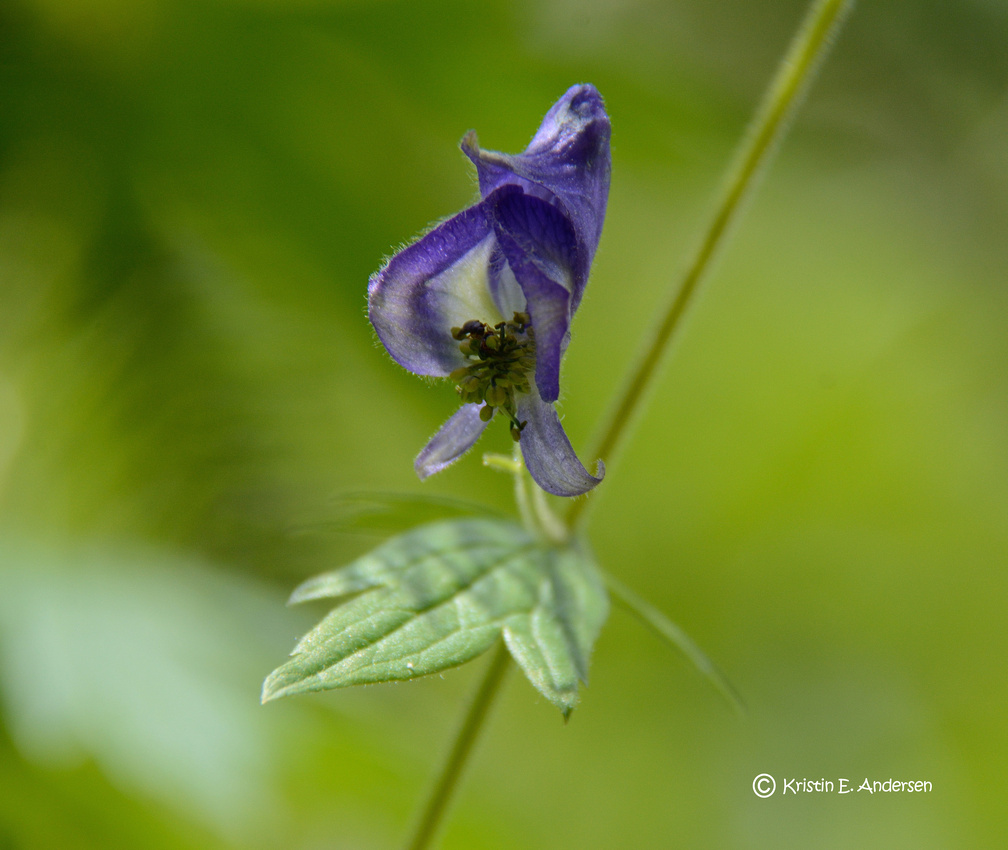Sepal secrets: What’s under the Monkshood’s hood?


One of Monkshood’s sepals does something really cool. It forms that distinctive “hood” shape that gives this plant its wonderful common name. The hood conceals a key clue to Monkshood’s heritage.
There are a couple of spurs under there – or “spurlike” petals.(1) Spurs should remind you of Columbines, of course, and also Delphiniums (Larkspurs). Like its cousins, Monkshood (most commonly Aconitum columbianum in Colorado) is a member of the Buttercup family, Ranunculaceae.
Also like Columbines and especially what I call the “big” Larkspurs (D. barbeyi and D. occidentale), Monkshood likes wet, shady places in Montane to Subalpine zones (roughly 8,000 feet to timberline). I’ve been accustomed to seeing it at higher elevations but recently I found it growing on the edges of seasonal streams at Meyer Ranch and Flying J Open Space parks in Jefferson County. Visit my gallery here.
By early August the water in these spots had stopped flowing but the ground was still moist enough to grow a few healthy Monkshood plants 3 to 4 feet tall. Seven feet isn’t unheard of for this plant whose stems can be “erect and stout to twining and reclining.”(3)
Reclining is how I’ve often seen it this year. That’s helpful for photographs – so much easier to shoot its “open racemes”(4) if it’s lying down or tipped over. By the way, my sources don’t entirely agree on whether Monkshood inflorescences are racemes or “panicles”(5) or “spike-like arrangements”(6), but you get the idea. Typically you’ll see from a couple to many flowers arranged loosely up the stem.
Aconitum columbianum flowers are most often blue – a blue so dark that some color-coded field guides group it in the purples. But – and there’s always a “but” with flora, isn’t there? – it can sometimes be “white, cream colored, or blue tinged at sepal margins."(7)
I can personally vouch for this crazy claim (a white Monkshood? Really?) because I happened on some just recently in the Mount Evans Wilderness growing near some Delphinium barbeyi. The Larkspurs were themselves notable for their unusual, at least to me, variegated cream/blue/purple flowers. Makes you wonder what’s in the water there.
If the experts don’t agree on inflorescences, they’re pretty squishy on the leaves, too. I’ve got “jaggedly toothed”(8), “toothed and cleft” with 3-5 divisions(9) or 3-7 divisions.(10) Only one source would say “palmately divided” out loud.(11) The thing to know is that the leaves are indeed deeply divided (not just in description). Without flowers, they can be mistaken for geraniums (specifically Richardson “white,” Geranium richardsonii) or superficially for Delphinium barbeyi. Craighead helpfully points out that leaves decrease in size as the stem lengthens, with the largest leaves at the bottom.(12)
At a glance, the leaves can fool you into thinking they’re “sessile” (lacking leafstalks). But it’s just the way they tuck in around the stem.
The genus Aconitum is known worldwide. Pliny thought the name had something to do with the ancient Black Sea port of Aconis.(13) North America has some 16 species. Thomas Nuttall, the enthusiastic 19th century amateur botanist and ornithologist, first identified Aconitum columbianum. “Columbianum” likely refers to the Columbia River where Nuttall traveled with the Wyeth Expedition in 1834.(14)
Aside from that hood-shaped sepal, the Aconites do have a dark side. “In various parts of the world they have been used medicinally and as a source of poisons throughout history.”(15) Colorado’s native species isn’t considered a very toxic one.(16) So, look all you want but don’t taste.
NOTES:
1 Guide to Colorado Wildflowers, Volume 2, by G.K. Guennel (1995)
2 http://www.efloras.org/florataxon.aspx?flora_id=1&taxon_id=100300
3 http://www.efloras.org/florataxon.aspx?flora_id=1&taxon_id=233500014
4 Guennel.
5 See Note 3.
6 Meet the Natives by M. Walter Pesman, revised and expanded by Dan Johnson (2012 edition)
7 See Note 3.
8 Guennel
9 Rocky Mountain Wildflowers: Peterson Field Guides by John J. Craighead, Frank C. Craighead Jr., Ray J. Davis (1991)
10 See Note 2.
11 Ibid.
12 Craighead.
13 See Note 2.
14 http://harvardmagazine.com/2015/05/thomas-nuttall
15 See Note 2.
16 See Note 3.